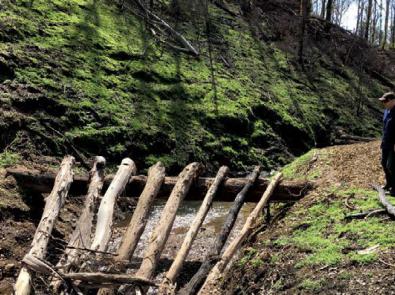Following research to identify processes that put burnt catchments at higher risk of debris flows, we are trialling structures that can mitigate flows and monitoring their effectiveness. Read this case study to learn more.
Sustainable Development Goals:
Goal 6: Clean water and sanitation
Background
Melbourne’s water supply is naturally high quality and low in turbidity and colour, and therefore largely remains unfiltered. But this can pose a risk to water quality through events such as fires and the resulting debris flows.
What is debris flow?
A debris flow is essentially an avalanche of soil and rock, caused by rainfall, that flows down a gully. They tend to occur on steep slopes covered in dry eucalypt forests, rather than in wetter forests growing at higher altitudes. The initiating rainfall does not need to be exceptionally large - even relatively small events of around 25mm an hour can cause them.
Debris flows can deliver many thousands of tonnes of sediment to streams or reservoirs, which may result in water turbidity that lasts for many months.
The probability of a debris flow increases after bushfire, and the risk remains high until vegetation has re-established. Although most debris flows can occur from 12 months up to two years after a fire, they may be a risk for many years after a fire affects an area.
Research focus
In February 2019 a significant fire burnt approximately 6,300 hectares of the forested Thomson catchment close to Bells Portal – the structure that controls water transfer from Thomson Reservoir to Upper Yarra Reservoir via a tunnel.
A debris flow in this area would release approximately 1,200 tonnes of sediment, with a heightened risk given the burnt area’s proximity to Bells Portal.
To address issues such as the Thomson catchment fire, we previously carried out research to identify the processes that put a burnt catchment at higher risk of a debris flow after fire. This led to the development of a model that identifies high-risk debris-flow locations, as well as structures that can mitigate debris flows.
Outcomes
To date, trial debris flow mitigation structures have been installed at some high-risk locations, and monitoring for the effectiveness and refinement of the designs is being carried out as needed.
You may also like...
Delivering on the Sustainable Development Goals
This report outlines Melbourne Water's unwavering commitment to advancing sustainability through the United Nations Sustainable Development Goals (SDGs).




